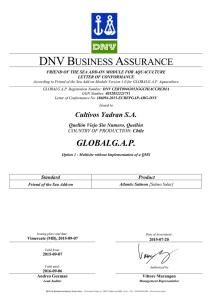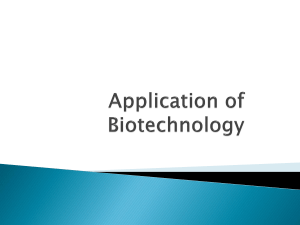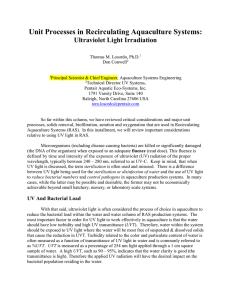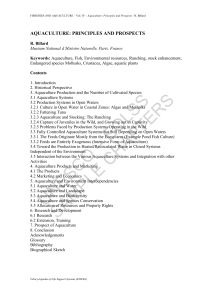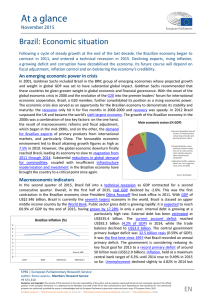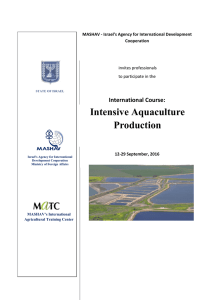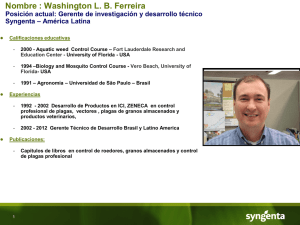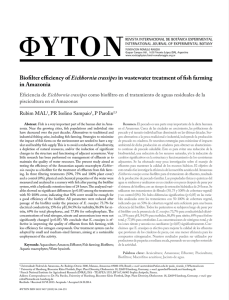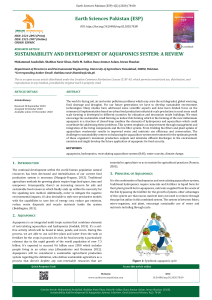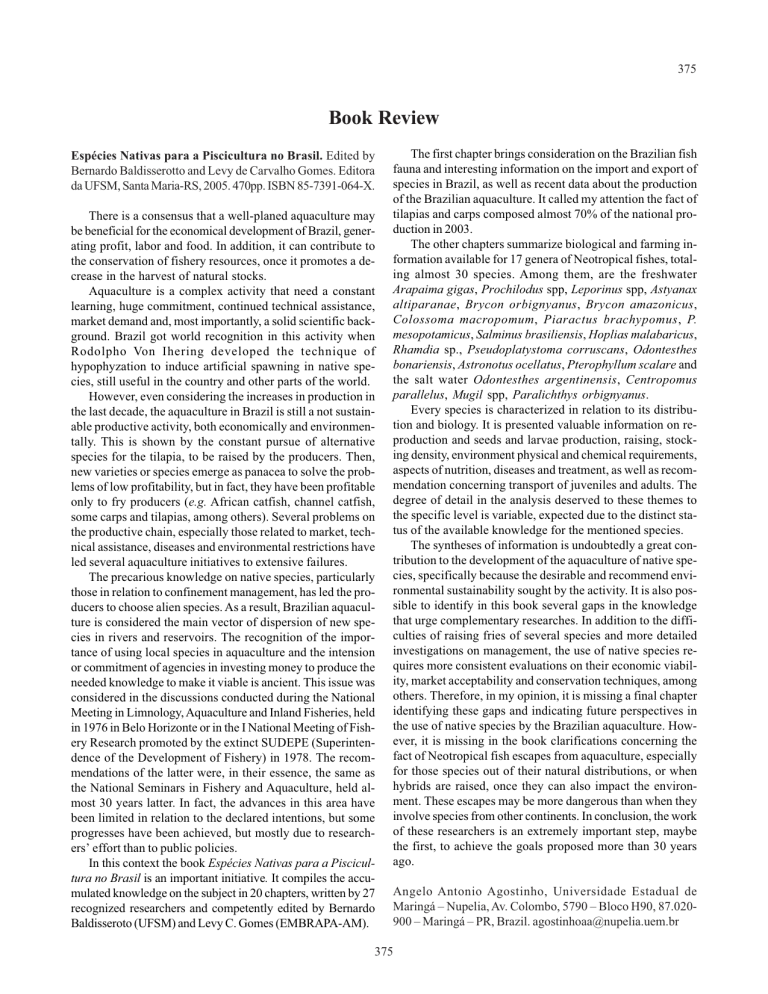
375 Book Review Espécies Nativas para a Piscicultura no Brasil. Edited by Bernardo Baldisserotto and Levy de Carvalho Gomes. Editora da UFSM, Santa Maria-RS, 2005. 470pp. ISBN 85-7391-064-X. There is a consensus that a well-planed aquaculture may be beneficial for the economical development of Brazil, generating profit, labor and food. In addition, it can contribute to the conservation of fishery resources, once it promotes a decrease in the harvest of natural stocks. Aquaculture is a complex activity that need a constant learning, huge commitment, continued technical assistance, market demand and, most importantly, a solid scientific background. Brazil got world recognition in this activity when Rodolpho Von Ihering developed the technique of hypophyzation to induce artificial spawning in native species, still useful in the country and other parts of the world. However, even considering the increases in production in the last decade, the aquaculture in Brazil is still a not sustainable productive activity, both economically and environmentally. This is shown by the constant pursue of alternative species for the tilapia, to be raised by the producers. Then, new varieties or species emerge as panacea to solve the problems of low profitability, but in fact, they have been profitable only to fry producers (e.g. African catfish, channel catfish, some carps and tilapias, among others). Several problems on the productive chain, especially those related to market, technical assistance, diseases and environmental restrictions have led several aquaculture initiatives to extensive failures. The precarious knowledge on native species, particularly those in relation to confinement management, has led the producers to choose alien species. As a result, Brazilian aquaculture is considered the main vector of dispersion of new species in rivers and reservoirs. The recognition of the importance of using local species in aquaculture and the intension or commitment of agencies in investing money to produce the needed knowledge to make it viable is ancient. This issue was considered in the discussions conducted during the National Meeting in Limnology, Aquaculture and Inland Fisheries, held in 1976 in Belo Horizonte or in the I National Meeting of Fishery Research promoted by the extinct SUDEPE (Superintendence of the Development of Fishery) in 1978. The recommendations of the latter were, in their essence, the same as the National Seminars in Fishery and Aquaculture, held almost 30 years latter. In fact, the advances in this area have been limited in relation to the declared intentions, but some progresses have been achieved, but mostly due to researchers’ effort than to public policies. In this context the book Espécies Nativas para a Piscicultura no Brasil is an important initiative. It compiles the accumulated knowledge on the subject in 20 chapters, written by 27 recognized researchers and competently edited by Bernardo Baldisseroto (UFSM) and Levy C. Gomes (EMBRAPA-AM). The first chapter brings consideration on the Brazilian fish fauna and interesting information on the import and export of species in Brazil, as well as recent data about the production of the Brazilian aquaculture. It called my attention the fact of tilapias and carps composed almost 70% of the national production in 2003. The other chapters summarize biological and farming information available for 17 genera of Neotropical fishes, totaling almost 30 species. Among them, are the freshwater Arapaima gigas, Prochilodus spp, Leporinus spp, Astyanax altiparanae, Brycon orbignyanus, Brycon amazonicus, Colossoma macropomum, Piaractus brachypomus, P. mesopotamicus, Salminus brasiliensis, Hoplias malabaricus, Rhamdia sp., Pseudoplatystoma corruscans, Odontesthes bonariensis, Astronotus ocellatus, Pterophyllum scalare and the salt water Odontesthes argentinensis, Centropomus parallelus, Mugil spp, Paralichthys orbignyanus. Every species is characterized in relation to its distribution and biology. It is presented valuable information on reproduction and seeds and larvae production, raising, stocking density, environment physical and chemical requirements, aspects of nutrition, diseases and treatment, as well as recommendation concerning transport of juveniles and adults. The degree of detail in the analysis deserved to these themes to the specific level is variable, expected due to the distinct status of the available knowledge for the mentioned species. The syntheses of information is undoubtedly a great contribution to the development of the aquaculture of native species, specifically because the desirable and recommend environmental sustainability sought by the activity. It is also possible to identify in this book several gaps in the knowledge that urge complementary researches. In addition to the difficulties of raising fries of several species and more detailed investigations on management, the use of native species requires more consistent evaluations on their economic viability, market acceptability and conservation techniques, among others. Therefore, in my opinion, it is missing a final chapter identifying these gaps and indicating future perspectives in the use of native species by the Brazilian aquaculture. However, it is missing in the book clarifications concerning the fact of Neotropical fish escapes from aquaculture, especially for those species out of their natural distributions, or when hybrids are raised, once they can also impact the environment. These escapes may be more dangerous than when they involve species from other continents. In conclusion, the work of these researchers is an extremely important step, maybe the first, to achieve the goals proposed more than 30 years ago. Angelo Antonio Agostinho, Universidade Estadual de Maringá – Nupelia, Av. Colombo, 5790 – Bloco H90, 87.020900 – Maringá – PR, Brazil. [email protected] 375
